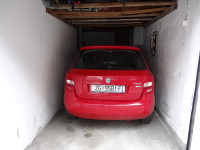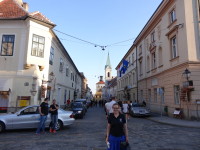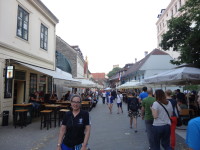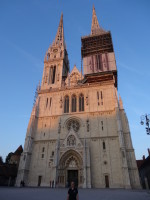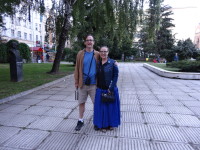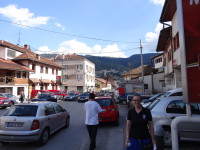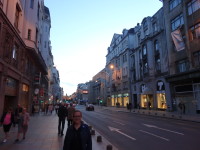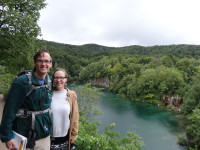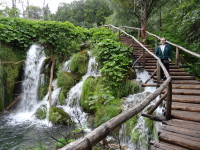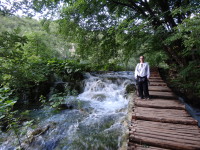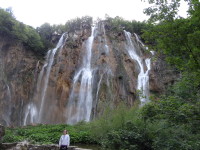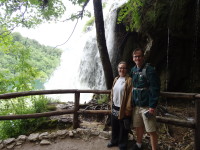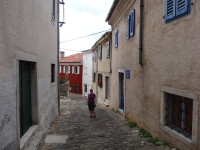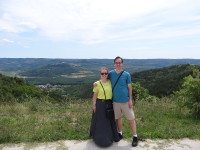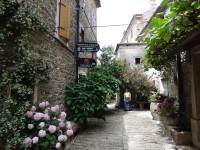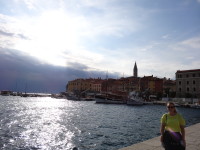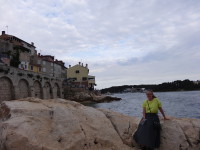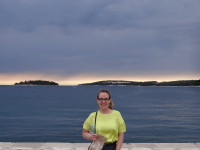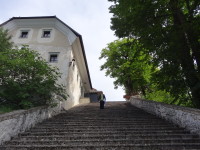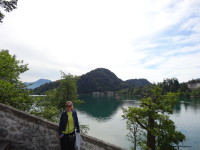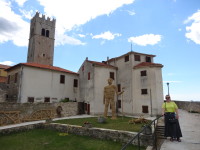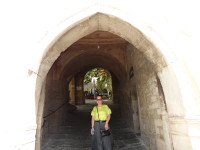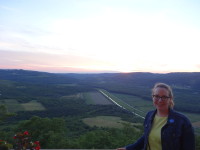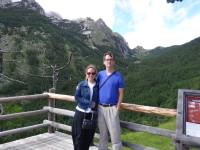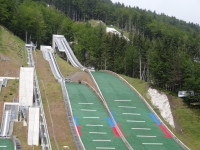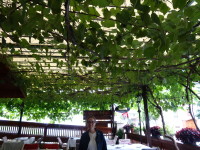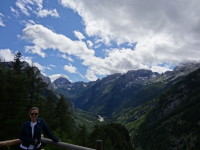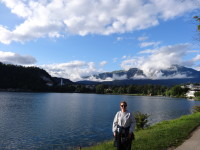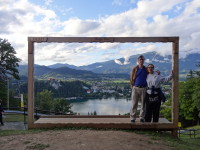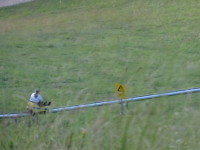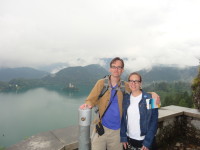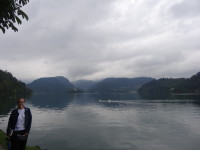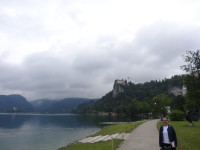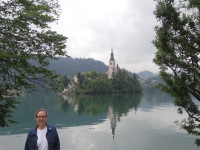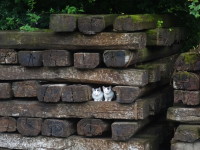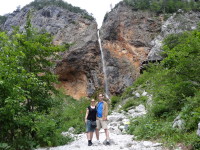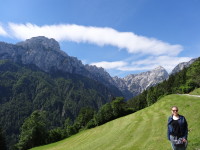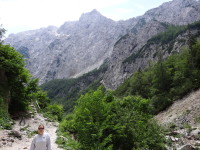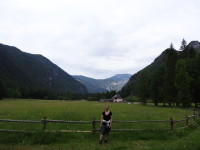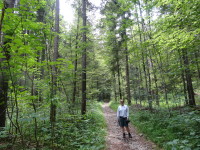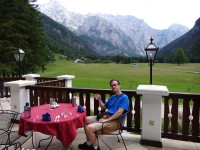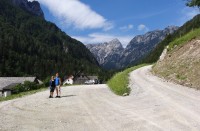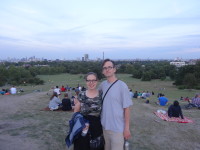 Mer and I were trying to leave our various Balkan lands with as little foreign money as possible. We knew we needed eighty kuna to get back to the airport via tram and bus, and we did not want to take out more money. That left us with fourteen kuna to use for buying breakfast. Fourteen kuna is about two dollars, so we were not too hopeful. We did go to a bakery with the hopes of finding something, and we came away with a roll, a pastry, and a muffin. For two dollars. There are some benefits to the strong dollar. We ate breakfast in our hostel’s very nice enclosed courtyard.
Mer and I were trying to leave our various Balkan lands with as little foreign money as possible. We knew we needed eighty kuna to get back to the airport via tram and bus, and we did not want to take out more money. That left us with fourteen kuna to use for buying breakfast. Fourteen kuna is about two dollars, so we were not too hopeful. We did go to a bakery with the hopes of finding something, and we came away with a roll, a pastry, and a muffin. For two dollars. There are some benefits to the strong dollar. We ate breakfast in our hostel’s very nice enclosed courtyard.
On the way to the tram, we passed by an early morning musician who sure sounded as if he was singing the Croatian version of the traveling song “Five Hundred Miles.” Mer and I had been singing that the day before in the car, so that was both funny and very, very strange, and got us quietly singing along in English, but changing the “five hundred” miles in the lyrics to “five thousand miles.”
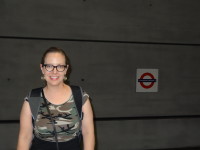 We got to the airport and then on our flight with little difficulty. I had us at the gate ninety minutes early – it only took twenty-five minutes to go from the bus to the gate. I expect we will not be that efficient at Heathrow tomorrow. Mer, in her brilliance, had remembered that our bags would be tagged to go through to Toronto, so we remembered to pack a few clothes in our carry-ons so we would have them for our twenty-three-hour layover in London.
We got to the airport and then on our flight with little difficulty. I had us at the gate ninety minutes early – it only took twenty-five minutes to go from the bus to the gate. I expect we will not be that efficient at Heathrow tomorrow. Mer, in her brilliance, had remembered that our bags would be tagged to go through to Toronto, so we remembered to pack a few clothes in our carry-ons so we would have them for our twenty-three-hour layover in London.
And so we arrived in London, with one evening free to explore. We got day passes for the Tube (the subway), and away we went. And went. And went. London is huge. I had hoped to make an evensong service at my favorite church building in the world, St. Paul’s Cathedral, but it started at 5:00. I soon came to the conclusion that we were not going to make it if we went to our B and B first, so we headed to St. Paul’s, backpacks in tow. It had taken about an hour and a half to get from Heathrow to St. Paul’s. That will need to be taken into account for the return trip tomorrow.
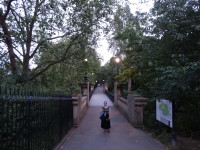 The service at St. Paul’s was pretty well attended. I’m sure many people were there as tourists and not so much as worshipers, but the service went off well. The choir started out singing a cappella in that magnificent space, and that was amazing. The evensong service lasted about forty minutes. I do admit my mind wandered during one of the longer choir/organ pieces of music from the fifteenth century, but on the whole, I was very glad we had made time for it.
The service at St. Paul’s was pretty well attended. I’m sure many people were there as tourists and not so much as worshipers, but the service went off well. The choir started out singing a cappella in that magnificent space, and that was amazing. The evensong service lasted about forty minutes. I do admit my mind wandered during one of the longer choir/organ pieces of music from the fifteenth century, but on the whole, I was very glad we had made time for it.
For some reason, Boy Genius had not printed out directions to the B and B, so it took a couple of Tube stops and a couple of tries to find the place, but we finally checked in around 7:00 pm. We then headed down the block to a pub recommended by our B and B – the Washington. I was sold on it since it had couches and leather chairs, and it had classic pub grub. The Washington theme was carried even to the bathrooms, which were labeled “Presidents” and “First Ladies.” It was a great place to eat and hang out.
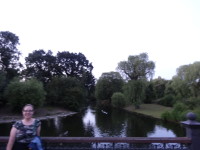 Next on our list, after a quick return to the B and B for internet directions, was to walk over to Primrose Hill, a park about ten minutes away. Our B and B booklet said it had great views of downtown London, which it did. Meredith confided to me that when we came to the park, she was surprised, thinking that parks are nice, but that she’d thought I would do something more specific to London. She changed her mind when she saw the skyline. While we were admiring the view, I saw some strange-looking nets a little ways away, so we investigated.
Next on our list, after a quick return to the B and B for internet directions, was to walk over to Primrose Hill, a park about ten minutes away. Our B and B booklet said it had great views of downtown London, which it did. Meredith confided to me that when we came to the park, she was surprised, thinking that parks are nice, but that she’d thought I would do something more specific to London. She changed her mind when she saw the skyline. While we were admiring the view, I saw some strange-looking nets a little ways away, so we investigated.
I think it was bird netting of an aviary of the London Zoo, which was closed at the time, but it did help us to stumble across Regent’s Park, an enormous park of 350-plus acres that we had never seen on our previous trips. We spent a good thirty or forty minutes wandering in Regent’s Park, and we never even got to the gardens that I wanted to see. We were running out of daylight, so we headed back up Primrose Hill to admire the city all lit up, which was beautiful. There is one building that (we hope) is still going up that looks at the moment like a poor 1960s version of the CN Tower in Toronto, and it is a bit of an eyesore on the London skyline. I’m hoping it will improve as it gets finished.
 That ended the London sightseeing part of our trip, and tomorrow we get to look forward to the long transatlantic flight, followed by a five-hour drive home. Still, it will be good to get home, put the suitcases away, and pet some kitties.
That ended the London sightseeing part of our trip, and tomorrow we get to look forward to the long transatlantic flight, followed by a five-hour drive home. Still, it will be good to get home, put the suitcases away, and pet some kitties.
Oh – Meredith pointed out that we have ended up in three different capital cities in three days – Sarajevo, Zagreb, and then London. Neat!
